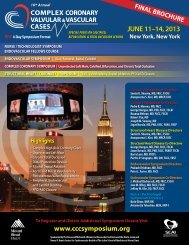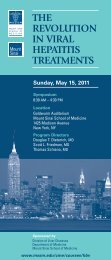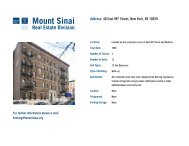CARDIAC CATH LAB - Mount Sinai Hospital
CARDIAC CATH LAB - Mount Sinai Hospital
CARDIAC CATH LAB - Mount Sinai Hospital
Create successful ePaper yourself
Turn your PDF publications into a flip-book with our unique Google optimized e-Paper software.
Participation in clinical<br />
trials including the<br />
PROSPECT trial has<br />
contributed to our<br />
knowledge of vulnerable<br />
plaques, which often<br />
elude detection under<br />
traditional screening.<br />
Pedro Moreno, MD, Director<br />
Interventional Research,<br />
Cardiac Cath Lab, on<br />
Advances in Vulnerable<br />
Plaque Treatment<br />
Despite steady improvement in the<br />
medical and interventional treatment<br />
of coronary artery disease, we<br />
continue to struggle with the fact<br />
that contemporary PCI, as good as it is,<br />
may not prevent an MI or even death<br />
in the seemingly stable patient. This is<br />
because life-threatening heart attacks<br />
arise most often from lesions — the<br />
so-called vulnerable plaques that escape conventional imaging technology.<br />
Recently <strong>Mount</strong> <strong>Sinai</strong>’s cath lab participated in the first large-scale<br />
systematic effort to change this condition, the PROSPECT Clinical Trial.<br />
This prospective study to evaluate the role of vulnerable plaque in the<br />
progression of coronary artery disease tracked 700 patients with acute<br />
coronary syndrome (ACS) in a three-year multicenter trial. After treating<br />
the precipitating lesion, and with patient consent, investigators went<br />
on to investigate the presence and composition of additional nonculprit,<br />
nonstenotic lesions (2,600 in all) in the three major arteries. Many of<br />
these lesions were not detectable in stress tests or coronary angiograms.<br />
However, using newly introduced imaging technology called virtual<br />
histology — an advanced version of intravascular ultrasound — we were<br />
able to systematically analyze plaque composition with regard to size<br />
and thickness on the basis of the distinct spectral parameters of each<br />
tissue substrate.<br />
From this data we went on to correlate various plaque characteristics,<br />
patient risk factors and plasma markers with plaque progression and<br />
adverse cardiac events that subsequently occurred among participants.<br />
The results — based on literally hundreds of thousands of frames<br />
viewed by VH-IVUS and angiography — gave us a statistical picture<br />
of the common features of these nonocclusive lesions, which turn<br />
out to be more dangerous than occlusive hard plaques.<br />
22 <strong>Mount</strong> <strong>Sinai</strong> <strong>Hospital</strong> Cardiac Cath Lab


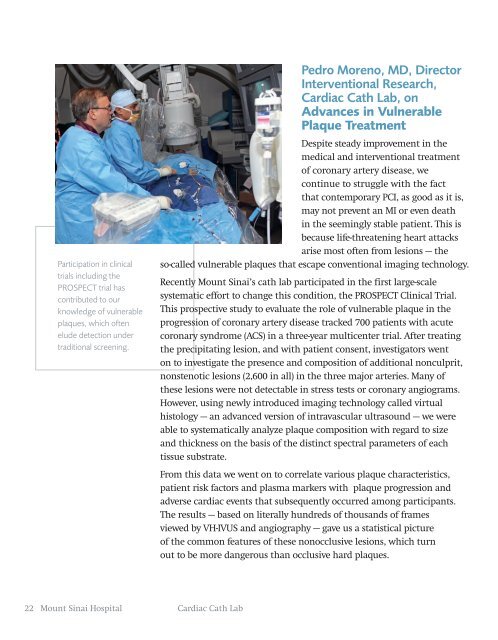
![December 2, 2012 [PDF] - Mount Sinai Hospital](https://img.yumpu.com/51092274/1/190x245/december-2-2012-pdf-mount-sinai-hospital.jpg?quality=85)
![January 21, 2013 [PDF] - Mount Sinai Hospital](https://img.yumpu.com/50916550/1/190x245/january-21-2013-pdf-mount-sinai-hospital.jpg?quality=85)

![February 3, 2013 [PDF] - Mount Sinai Hospital](https://img.yumpu.com/50584982/1/190x245/february-3-2013-pdf-mount-sinai-hospital.jpg?quality=85)
![March 18, 2012 [PDF] - Mount Sinai Hospital](https://img.yumpu.com/50462098/1/190x245/march-18-2012-pdf-mount-sinai-hospital.jpg?quality=85)

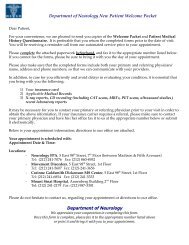
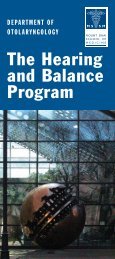
![Partners Program Guide [PDF] - Mount Sinai Hospital](https://img.yumpu.com/49411954/1/190x245/partners-program-guide-pdf-mount-sinai-hospital.jpg?quality=85)
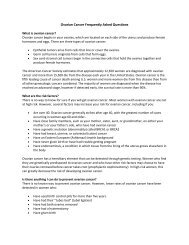
![March 19 - April 1, 2012 [PDF] - Mount Sinai Hospital](https://img.yumpu.com/48990923/1/190x245/march-19-april-1-2012-pdf-mount-sinai-hospital.jpg?quality=85)
![PGY-1 Residency Application [PDF] - Mount Sinai Hospital](https://img.yumpu.com/48577701/1/190x245/pgy-1-residency-application-pdf-mount-sinai-hospital.jpg?quality=85)
